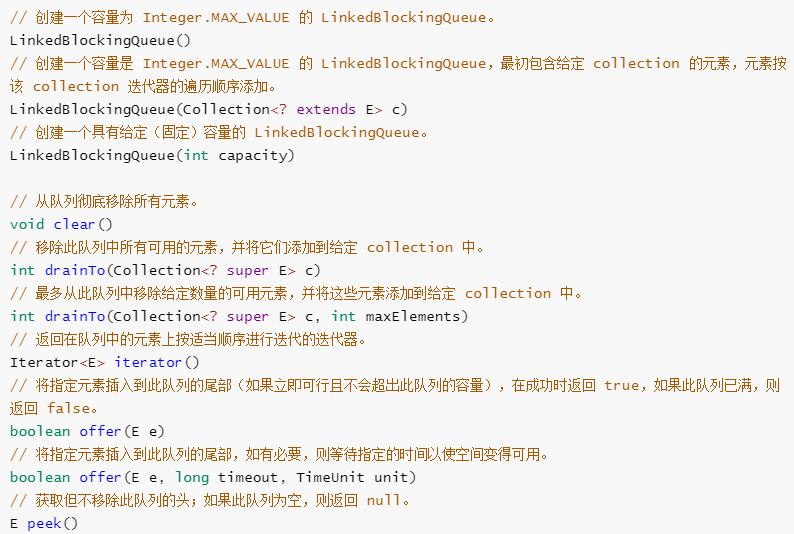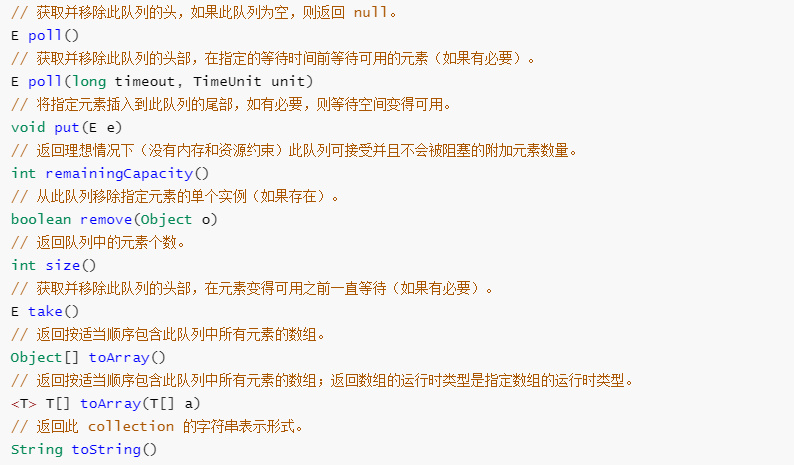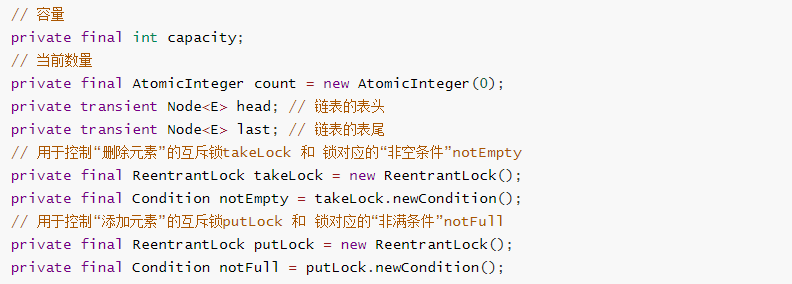线程池阻塞队列之LinkedBlockingQueue
LinkedBlockingQueue介绍
LinkedBlockingQueue是一个单向链表实现的阻塞队列。该队列按 FIFO排序元素,新元素插入到队列的尾部,并且队列获取操作会获得位于队列头部的元素。
此外,LinkedBlockingQueue可以指定队列的容量。如果不指定,默认容量大小等于Integer.MAX_VALUE。
LinkedBlockingQueue原理和数据结构
-
LinkedBlockingQueue继承于AbstractQueue,它本质上是一个FIFO(先进先出)的队列。
-
LinkedBlockingQueue实现了BlockingQueue接口,它支持多线程并发。当多线程竞争同一个资源时,某线程获取到该资源之后,其它线程需要阻塞等待。
-
LinkedBlockingQueue是通过单链表实现的:
-
head是链表的表头。取出数据时,都是从表头head处取出。
-
last是链表的表尾。新增数据时,都是从表尾last处插入。
-
count是链表的实际大小,即当前链表中包含的节点个数。
-
capacity是列表的容量,它是在创建链表时指定的。
-
putLock是插入锁,takeLock是取出锁;notEmpty是“非空条件”,notFull是“未满条件”。通过它们对链表进行并发控制。LinkedBlockingQueue在实现“多线程对竞争资源的互斥访问”时,对于“插入”和“取出(删除)”操作分别使用了不同的锁。对于插入操作,通过“插入锁putLock”进行同步;对于取出操作,通过“取出锁takeLock”进行同步。此外,插入锁putLock和“非满条件notFull”相关联,取出锁takeLock和“非空条件notEmpty”相关联。通过notFull和notEmpty更细腻的控制锁。
-
若某线程(线程A)要取出数据时,队列正好为空,则该线程会执行notEmpty.await()进行等待;当其它某个线程(线程B)向队列中插入了数据之后,会调用notEmpty.signal()唤醒“notEmpty上的等待线程”。此时,线程A会被唤醒从而得以继续运行。 此外,线程A在执行取操作前,会获取takeLock,在取操作执行完毕再释放takeLock。
若某线程(线程H)要插入数据时,队列已满,则该线程会它执行notFull.await()进行等待;当其它某个线程(线程I)取出数据之后,会调用notFull.signal()唤醒“notFull上的等待线程”。此时,线程H就会被唤醒从而得以继续运行。 此外,线程H在执行插入操作前,会获取putLock,在插入操作执行完毕才释放putLock。
LinkedBlockingQueue函数列表


LinkedBlockingQueue源码分析
下面从LinkedBlockingQueue的创建,添加,删除,遍历这几个方面对它进行分析。
1. 创建
下面以LinkedBlockingQueue(int capacity)来进行说明。
说明:
-
capacity是“LinkedBlockingQueue”的容量。
-
head和last是“LinkedBlockingQueue”的首节点和尾节点。它们在LinkedBlockingQueue中的声明如下:

链表的节点定义如下:

2. 添加
下面以offer(E e)为例,对LinkedBlockingQueue的添加方法进行说明。
public boolean offer(E e) { if (e == null) throw new NullPointerException(); // 如果“队列已满”,则返回false,表示插入失败。 final AtomicInteger count = this.count; if (count.get() == capacity) return false; int c = -1; // 新建“节点e” Node<E> node = new Node(e); final ReentrantLock putLock = this.putLock; // 获取“插入锁putLock” putLock.lock(); try { // 再次对“队列是不是满”的进行判断。 // 若“队列未满”,则插入节点。 if (count.get() < capacity) { // 插入节点 enqueue(node); // 将“当前节点数量”+1,并返回“原始的数量” c = count.getAndIncrement(); // 如果在插入元素之后,队列仍然未满,则唤醒notFull上的等待线程。 if (c + 1 < capacity) notFull.signal(); } } finally { // 释放“插入锁putLock” putLock.unlock(); } // 如果在插入节点前,队列为空;则插入节点后,唤醒notEmpty上的等待线程 if (c == 0) signalNotEmpty(); return c >= 0; }
说明:offer()的作用很简单,就是将元素E添加到队列的末尾。 enqueue()的源码如下:
private void enqueue(Node<E> node) { // assert putLock.isHeldByCurrentThread(); // assert last.next == null; last = last.next = node; }
enqueue()的作用是将node添加到队列末尾,并设置node为新的尾节点! signalNotEmpty()的源码如下:
private void signalNotEmpty() { final ReentrantLock takeLock = this.takeLock; takeLock.lock(); try { notEmpty.signal(); } finally { takeLock.unlock(); } }
signalNotEmpty()的作用是唤醒notEmpty上的等待线程。
3. 取出
下面以take()为例,对LinkedBlockingQueue的取出方法进行说明。

说明:take()的作用是取出并返回队列的头。若队列为空,则一直等待。 dequeue()的源码如下:
private E dequeue() { // assert takeLock.isHeldByCurrentThread(); // assert head.item == null; Node<E> h = head; Node<E> first = h.next; h.next = h; // help GC head = first; E x = first.item; first.item = null; return x; }
dequeue()的作用就是删除队列的头节点,并将表头指向“原头节点的下一个节点”。 signalNotFull()的源码如下:
private void signalNotFull() { final ReentrantLock putLock = this.putLock; putLock.lock(); try { notFull.signal(); } finally { putLock.unlock(); } }
signalNotFull()的作用就是唤醒notFull上的等待线程。
4. 遍历
public Iterator<E> iterator() { return new Itr(); }
iterator()实际上是返回一个Iter对象。 Itr类的定义如下:
private class Itr implements Iterator<E> { // 当前节点 private Node<E> current; // 上一次返回的节点 private Node<E> lastRet; // 当前节点对应的值 private E currentElement; Itr() { // 同时获取“插入锁putLock” 和 “取出锁takeLock” fullyLock(); try { // 设置“当前元素”为“队列表头的下一节点”,即为队列的第一个有效节点 current = head.next; if (current != null) currentElement = current.item; } finally { // 释放“插入锁putLock” 和 “取出锁takeLock” fullyUnlock(); } } // 返回“下一个节点是否为null” public boolean hasNext() { return current != null; } private Node<E> nextNode(Node<E> p) { for (;;) { Node<E> s = p.next; if (s == p) return head.next; if (s == null || s.item != null) return s; p = s; } } // 返回下一个节点 public E next() { fullyLock(); try { if (current == null) throw new NoSuchElementException(); E x = currentElement; lastRet = current; current = nextNode(current); currentElement = (current == null) ? null : current.item; return x; } finally { fullyUnlock(); } } // 删除下一个节点 public void remove() { if (lastRet == null) throw new IllegalStateException(); fullyLock(); try { Node<E> node = lastRet; lastRet = null; for (Node<E> trail = head, p = trail.next; p != null; trail = p, p = p.next) { if (p == node) { unlink(p, trail); break; } } } finally { fullyUnlock(); } } }
import java.util.*; import java.util.concurrent.*; /* * LinkedBlockingQueue是“线程安全”的队列,而LinkedList是非线程安全的。 * * 下面是“多个线程同时操作并且遍历queue”的示例 * (01) 当queue是LinkedBlockingQueue对象时,程序能正常运行。 * (02) 当queue是LinkedList对象时,程序会产生ConcurrentModificationException异常。 * */ public class LinkedBlockingQueueDemo1 { // TODO: queue是LinkedList对象时,程序会出错。 //private static Queue<String> queue = new LinkedList<>(); private static Queue<String> queue = new LinkedBlockingQueue<>(); public static void main(String[] args) { // 同时启动两个线程对queue进行操作! new MyThread("ta").start(); new MyThread("tb").start(); } private static void printAll() { String value; Iterator iter = queue.iterator(); while(iter.hasNext()) { value = (String)iter.next(); System.out.print(value+", "); } System.out.println(); } private static class MyThread extends Thread { MyThread(String name) { super(name); } @Override public void run() { int i = 0; while (i++ < 6) { // “线程名” + "-" + "序号" String val = Thread.currentThread().getName()+i; queue.add(val); // 通过“Iterator”遍历queue。 printAll(); } } } }
其中一次运行结果:
tb1, ta1,
tb1, ta1, ta2,
tb1, ta1, ta2, ta3,
tb1, ta1, ta2, ta3, ta4,
tb1, ta1, tb1, ta2, ta1, ta3, ta2, ta4, ta3, ta5,
ta4, tb1, ta5, ta1, ta6,
ta2, tb1, ta3, ta1, ta4, ta2, ta5, ta3, ta6, ta4, tb2,
ta5, ta6, tb2,
tb1, ta1, ta2, ta3, ta4, ta5, ta6, tb2, tb3,
tb1, ta1, ta2, ta3, ta4, ta5, ta6, tb2, tb3, tb4,
tb1, ta1, ta2, ta3, ta4, ta5, ta6, tb2, tb3, tb4, tb5,
tb1, ta1, ta2, ta3, ta4, ta5, ta6, tb2, tb3, tb4, tb5, tb6,
结果说明: 示例程序中,启动两个线程(线程ta和线程tb)分别对LinkedBlockingQueue进行操作。以线程ta而言,它会先获取“线程名”+“序号”,然后将该字符串添加到LinkedBlockingQueue中;接着,遍历并输出LinkedBlockingQueue中的全部元素。 线程tb的操作和线程ta一样,只不过线程tb的名字和线程ta的名字不同。 当queue是LinkedBlockingQueue对象时,程序能正常运行。如果将queue改为LinkedList时,程序会产生ConcurrentModificationException异常。



